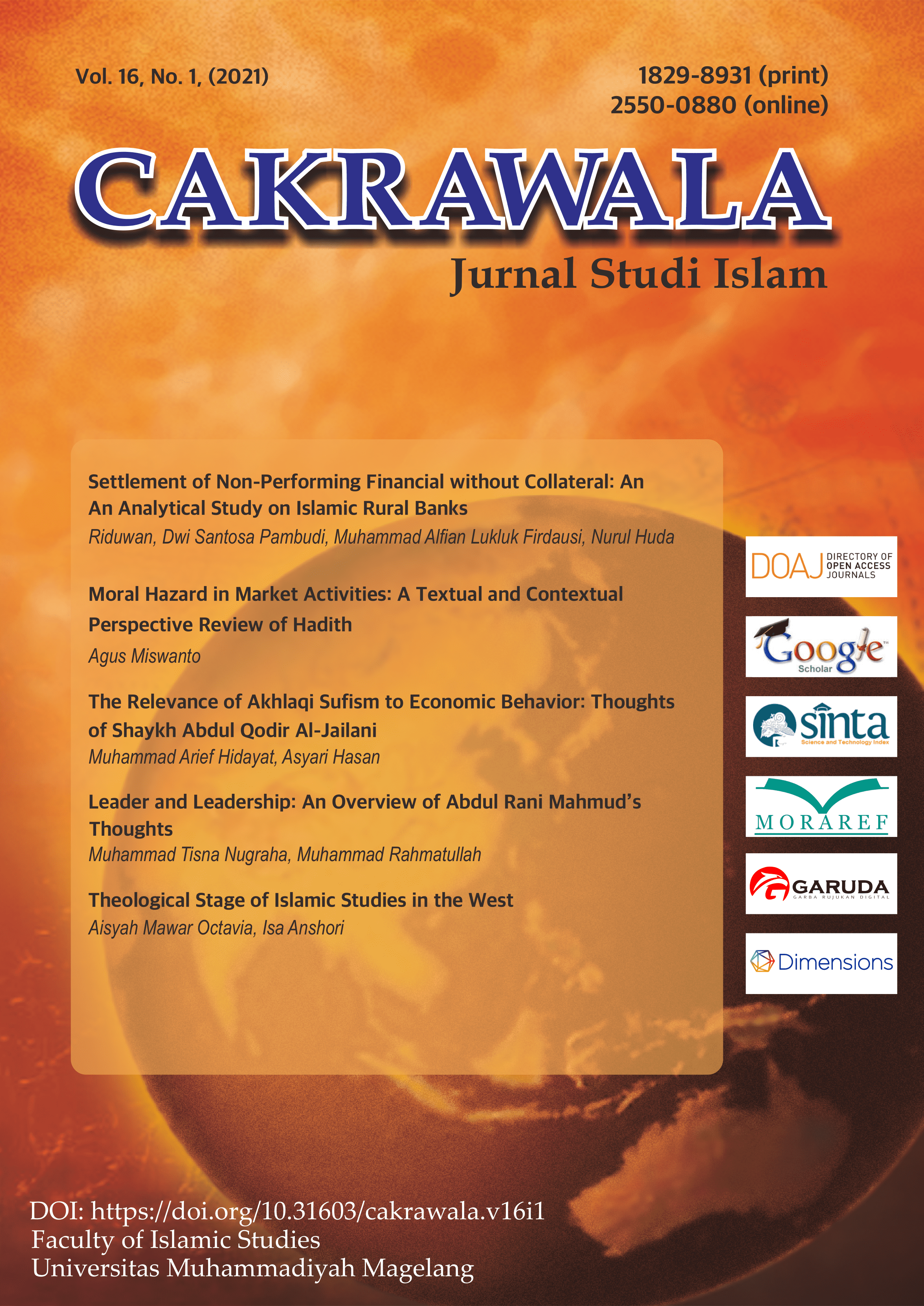Main Article Content
Abstract
Financing through Islamic banks carries a high risk of not being paid according to the contract's terms. As a result, Islamic banks must adhere to a stricter prudence standard. This research looks at the problem-solving model of non-collateral financing, which is influenced by both internal and external factors and carries a higher risk because the client lacks a material legal bond. The research sample consisted of 30 Indonesian Islamic Rural Banks' (BPRS) directors and commissioners. Questionnaires and in-depth interviews were used to collect data, which was then analyzed using content analysis techniques. The findings of this study show that the non-performing financing settlement model is implemented with early business assistance and then followed by financing relaxation. If no solution is found or the client declares bankruptcy, they may be released with a write-off using reserve funds from the account of writing off accounts receivable or social funds.
Keywords
Article Details

This work is licensed under a Creative Commons Attribution-NonCommercial 4.0 International License.
References
- AAOIFI. (2015). Shari’ah Standar. Dar Alma Iman.
- Ahmed, H. (2010). Risk Management Assesment System: An Application to Islamic Banks. Proceeding of the Bank of Indonesia.
- Ahmed, H. (2014). Islamic Banking and Sharia Compliance: A Product Development Perspective. Journal of Islamic Finance, 3(2), 15-29.
- Alalo, A. A. M., & Alalubosa, A. H. (2018). Potential of Sharīah Compliant Microfinance in Alleviating Poverty in Nigeria A lesson from Bangladesh. International Journal of Islamic and Middle Eastern Finance and Management, 5(3),14-32.
- Alandejani, M. & Asutay, M. (2017). Nonperforming Loans in the GCC Banking Sectors: Does the Islamic Finance Matter?. Research in International Business and Finance, 42, 832-854.
- Allen, M. Carpenter, C., Hutchins, M., & Jones, G. (2015). Impact of Risk Management on Project Cost: An Industry Comparison. Journal of Information Technology and Economic Development, 6(2), 1-19.
- Arifin, Z. (2002). Dasar-Dasar Manajemen Bank Syariah. Alfabeta.
- Auda, J. (2007). Maqashid al Shariah As Philosophy of Islamic Law. The International Institute of Islamic Thought.
- Awan, H. M., Bukhari, K. S., & Iqbal, A. (2011). Service quality and customer satisfaction in the banking sector: A comparative study of conventional and Islamic banks in Pakistan. Journal of Islamic Marketing, 2(3), 203-224.
- Chatta, J. A. & Alhabshi, S. M. S. J. (2017). Risk Management in Chaning Benchmark Rates Regime: Prudential Implication for Islamic Banks and Supervisors. Journal of Islamic Finance, 6(special issue), 205-230.
- Chatta, J. A. & Bacha, O. I. (2017). Duration Gabs and Net Worth Risk for Islamic and Conventional Banks; Comparative Cross Country Analisys. Review of Islamic Economic, 3(1), 5-33.
- Dasuki, A. W. (2007). Banking for the poor: the role of Islamic banking in microfinance initiatives. Proceedings of the 2nd Islamic Conference 2007 (iECONS2007).
- de Mooij, M., & Hofstede, G. (2011). Cross-Cultural Consumer Behavior: A Reviewof Research Findings. Journal of International Consumer Marketing, 23, 181–192.
- Gupta, P. K. (2011). Risk Management in Indian Companies: EWRM Concern and Issues. The Journal of Risk Finance, 12(2), 121-139.
- Hadisumarto. W. M. C., & Ismail, A. G. B. (2010). Improving the Effectiveness of Islamic Micro-Financing: Learning from BMT Experience, Humanomics, 26(1), 65-75.
- Hanafi, M. M. (2012). Manajemen Risiko. UPP AMP YKPN.
- Harahap, B. (2006). Kedudukan, Fungsi dan Problematika Jaminan dalam Perjanjian Pembiayaan Mudharabah pada Bank Syariah. Jurnal Yustisia, 69.
- Hassan, A., & Harahap, S. S. (2010). Exploring corporate social responsibility disclosure: the case of Islamic banks. International Journal of Islamic and Middle Eastern Finance and Management, 3(3), 203-227.
- Hussain, H. A. & Al-Ajmi, J. (2012). Risk Management Practices of Conventional and Islamic Banks in Bahrain. Journal of Risk Finance, 13(3), 215-239.
- Ibtissem, B., & Bouri, A. (2013). Credit Risk Management In Microfinance: The Conceptual Framework. ACRN Journal of Finance and Risk Perspective, 2(1), 9-24.
- Karim, A. W. (2000). Incentive Compatible Constrain for Islamic Banking Some Leassons from Bank Muamalat Indonesia. Fourth International Conference on Islamic Economics and Banking.
- Khan, T. & Ahmed, H. (2001). Risk Management an Analysis of Issues in Islamic Financial Industry. Islamic Development Bank-Islamic Research and Training Institute.
- Mannan, S. K. A., & Abdullah, M. A. (2012). Perception of Small and Medium Sizes Enterprises in Klang Vallay Malaysia towards Profit and Loss Sharing Mode of Financing. Malaysian Journal of Economic Studies, 49(1), 37-48.
- Mulyono, T. P. (2001). Manajemen Perkreditan bagi Bank Komersiil. BPFE.
- OJK. (2018). Statistik Perbankan Syariah Desember 2018.
- Preda, C. (2013). Implementating A Risk Management Standard. Journal of Defense Resources Management, 4(1), 111-120.
- Riduwan & Pranata, G. D. (2020). Risk Analisys of Sharia Bank Financing Contract. IHTIFAZ: Journal of Islamic Economic, Finance and Banking, 3(1), 1-14.
- Riduwan & Rifan, A. A. (2018). Konstruksi Bank Syariah Indonesia. UAD Press.
- Riduwan. (2019). Sistem Pembiayaan Mudarabah pada Bank Syariah Analisis Terhadap Kepatuhan Syariah dan Risiko. UII Yogyakarta.
- Rustam, B. R. (2013). Manajemen Risiko Perbankan Syariah. Salemba Empat.
- Sadique, M. A. (2013). Contractual Term In Musharakah and Mudharabah Restricting the Profit Share of a Partner or Facitating Later Amandements to the Agreed Ratio A Scrutiny. IIUM Law Journal, 21(1), 33-59.
- Sekreter, A. (2011). Sharing of Risk in Islamic Finance. IBSU Scientific Journal, 5(2), 13-20.
- Usman, A. B. S., & Tasmin, R. (2016). The Role of Islamic Micro Finance in Enhanching Human Development in Muslim Countries. Journal of Islamic Finance, 5(1), 53-62.

